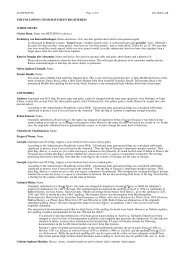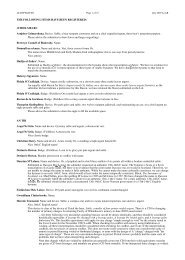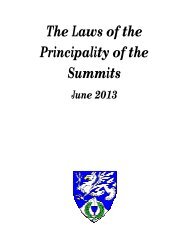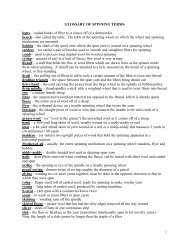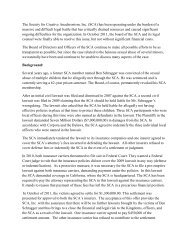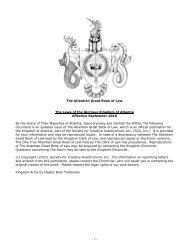The Standards for Evaluation of Names and Armory - SCA Heraldry
The Standards for Evaluation of Names and Armory - SCA Heraldry
The Standards for Evaluation of Names and Armory - SCA Heraldry
Create successful ePaper yourself
Turn your PDF publications into a flip-book with our unique Google optimized e-Paper software.
GermanDoubleGiven<strong>Names</strong>German Yes Adjectival(common), marked,<strong>and</strong> inn signs<strong>The</strong> <strong>St<strong>and</strong>ards</strong> <strong>for</strong> <strong>Evaluation</strong> <strong>of</strong> <strong>Names</strong> <strong>and</strong> <strong>Armory</strong>:<strong>The</strong> Rules <strong>for</strong> SubmissionsLocative Patronymic OtherrelationshipUnmarked,rarelymarkedWomen may usefeminine <strong>for</strong>m(see notes)Descriptive/OccupationalYes; usuallywithoutarticlesDictus Double Bynames OrderEarly (seeLatinizednames)Rare; second bynameis usually locative ordescriptivegiven+bynamegiven+byname+locativegiven+byname+descriptNotes: Locatives based on place names use the <strong>for</strong>ms von X; generic toponymics use vom Y, or another <strong>for</strong>m <strong>of</strong> der; the <strong>for</strong>m de X is found be<strong>for</strong>e about 1300. Locativesbased on generic toponyms, house names or inn-sign names use the <strong>for</strong>m zum Z.Women commonly used a feminized <strong>for</strong>m <strong>of</strong> their husb<strong>and</strong>’s or father’s surname, either by adding the suffix –in/-yn, or used a genitive <strong>for</strong>m ending in –s/-z or -en.Unmodified surnames were also used. Further discussion <strong>of</strong> women’s bynames can be found in Aryanhwy merch Catmael, "Women's Surnames in 15th- <strong>and</strong> 16th-Century Germany" (http://www.ellipsis.cx/~liana/names/german/womenssurnames.html).Greek: Please refer to Bardas Xiphias, "Personal <strong>Names</strong> <strong>of</strong> the Aristocracy in the Roman Empire During the Later Byzantine Era"(http://heraldry.sca.org/laurel/names/byzantine/introduction.html). All patterns documented in this article are registerable.Hungarian/Romanian:DoubleGiven<strong>Names</strong>Hungarian Adjectival (vernacular),phrase (de X), unmarked(Latinized)Romanian Phrase, adjectival (seearticle)Locative Patronymic OtherrelationshipUnmarked,rarely marked(as B-fi)metronymics(late period);wife (see notes)Descriptive/OccupationalYes; withoutarticlesDictusDoubleBynamesOrderbyname+given (vernacular)given+byname (Latinized)See notes Yes given+bynameNotes: Hungarian: Women <strong>of</strong>ten have marital bynames that add –ne to her husb<strong>and</strong>'s complete name. See Walraven van Nijmegen, "Hungarian <strong>Names</strong> 101"(http://heraldry.sca.org/laurel/names/magyarnames1012.html) or various articles by Kolosvari Arpadne Julia in the KWHSS Proceedings <strong>for</strong> more details.Romanian: See Aryanhwy merch Catmael, "<strong>Names</strong> from the Royal Lines <strong>of</strong> Moldavia <strong>and</strong> Wallachia" (http://www.ellipsis.cx/~liana/names/other/romanian.html) <strong>for</strong>more details. <strong>The</strong> article does not document patronymic bynames, but that appears to be an artifact <strong>of</strong> the (royal) data.IberianCastilian(Spanish)DoubleGiven<strong>Names</strong>Locative Patronymic OtherrelationshipLate Phrase (de X;del Y or de laY), unmarked;Marked (seenotes), unmarkedDescriptive/OccupationalYes; usuallywithout articleDictusDoubleBynamesYes; secondbyname usuallylocativeOrdergiven+bynamegiven+pat+locativegiven+byname+locativeRules <strong>for</strong> Submissions - January, 2012




